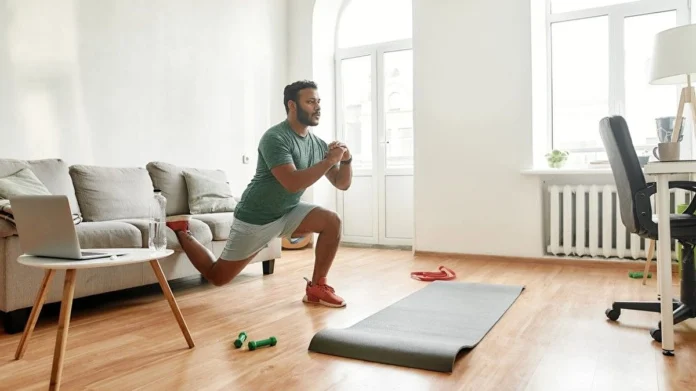How to Build Leg Muscles at Home?
Developing leg muscles at home is possible with a regular and conscious training program. Since leg muscles are one of the largest muscle groups in the body, strengthening them is important for overall performance and endurance. When doing leg muscle training at home, both unequipped and equipped methods can be preferred.
In this way, flexible programs can be created according to the equipment and training levels of individuals. Unequipped leg training at home is usually done using body weight. Basic movements such as squat, lunge, and calf raise can be done while doing upper leg training at home. These movements are especially suitable for beginner athletes and can be done without the need for additional equipment.
Home leg workouts can be supported with dumbbells, resistance bands, or small home weights. Such equipment increases the difficulty of the movements and accelerates muscle development. Squat or lunge exercises performed with dumbbells provide extra resistance to the muscles.
In addition, weighted leg workouts support the thickening and strengthening processes of the legs at home by enabling more intense stimulation of the muscle fibers. When preparing a program for leg muscle development movements at home, it is important to choose exercises that target different areas of the muscles in a balanced way.
Special movements should be applied for the lower leg, front leg, and back leg muscles. Regular and correct technique workouts provide an increase in muscle mass and significant strengthening in the legs over time. Proper rest and nutrition after exercise are necessary for the continuity of muscle development.
Home Leg Workout by Level
Home leg workout programs should be planned according to the person’s physical level and experience. Determining exercises suitable for each level both reduces the risk of injury and supports muscle development. Training programs are divided into beginner, intermediate, and advanced levels; they include movements with difficulty appropriate to the individual’s performance. This approach provides sustainable and effective leg muscle development. Basic movements should be preferred at the beginner level. Squats with body weight, chair leg movements, and light lunge exercises are ideal for the muscles’ adaptation process. At this stage, it is important to perform the movements with correct form and avoid excessive strain.
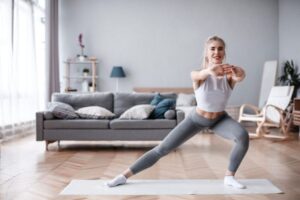
In intermediate-level training, movement variety is increased, and resistance can be added. Exercises such as squats, lunges, and calf raises are made more difficult by using equipment such as dumbbells or resistance bands. At this stage, the training duration and number of repetitions are increased. In addition, more emphasis is placed on movements targeting the hamstring and front leg muscles.
When practiced regularly, a noticeable increase in muscle mass and strength can be achieved. Advanced-level programs consist of more intense and weighted exercises. At this level, weighted squats, deadlift-like movements, and plyometric exercises may be included. The aim is to maximize muscle endurance and strength. In addition, special movements that work the muscles from different angles are also included in the program. Advanced-level training is suitable for experienced individuals with advanced body control.
Beginner Leg Workout
The aim of leg training at the beginner level is to strengthen the muscles and perform basic movements with correct form. Avoiding excessive strain at this stage is important to prepare the muscles for the adaptation process. Regular and controlled exercises create a solid foundation for advanced levels.
The movements that can be preferred at the beginner level are generally basic exercises such as squats, lunges, and calf raises performed with body weight. Chair Assisted Squat helps develop balance and muscle control. Movements such as the Bag Front Squat and the Bag Overhead Reverse Lunge effectively work different areas of the leg muscles. In addition, movement sets such as Shapely Legs of a Star and High-Spirit Leg Session are suitable for strengthening the leg muscles in a balanced way.
Side leg lift, glute bridge, and calf raise exercises targeting the calf muscles are also recommended for beginners. These exercises ensure that different parts of the muscles work equally and support muscle development.
At the beginner level, movements should be done slowly and under control, breath control and correct posture should be prioritized. In this way, the risk of injury is reduced and the muscles are worked efficiently. It is possible to develop calf muscles at home with regular practice.
Intermediate Leg Workout
For athletes who have moved on to the intermediate level, leg workouts include more resistance and movement variety. At this stage, muscle endurance is increased while strength gain is targeted. Intermediate-level programs work the leg muscles more effectively with new exercises added to the basic movements. Leg exercises performed at the intermediate level can be supported by using body weight, resistance bands, or light weights. One Leg Hip Abduction movements are performed separately for the right and left legs and strengthen the hip and outer thigh muscles. These exercises increase balance and muscle control while preventing muscle imbalance.
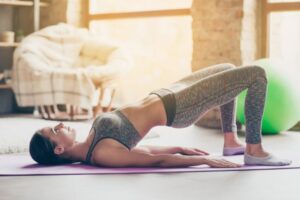
Quadriceps and hamstring muscle stretching exercises are important parts of intermediate-level training. Standing Quadriceps Stretch and Lying Hamstring Stretch exercises increase muscle flexibility, reduce the risk of injury, and speed up the recovery process. These stretching exercises can be applied as a warm-up routine before and a cool-down routine after training.
At the intermediate level, the weight and repetition count of basic movements such as squat, lunge, and calf raise are increased. Exercises using resistance bands or dumbbells provide more strain on the muscles.
Controlled and regular movements are critical for muscle development and increased performance. Intermediate-level exercises provide both strength and flexibility by working different muscle groups of the body in a balanced way. In this way, a solid foundation is prepared for the transition to the next level.
Advanced Leg Workout
For athletes who have reached an advanced level, leg workouts aim to maximize muscle development with high intensity and challenging movements. At this stage, strength, endurance, and flexibility are developed together. Advanced programs focus on complex and multi-joint movements, working all areas of the leg muscles in a balanced way.
In advanced leg workouts, movements that require deep stretching and strength, such as the Cossack Squat, are often preferred. This exercise strengthens both the front and back leg muscles, increases range of motion, and improves balance. The Prisoner Squat is a different type of squat performed with body weight, but with the hands behind the shoulders. This movement allows the core muscles and legs to work simultaneously.
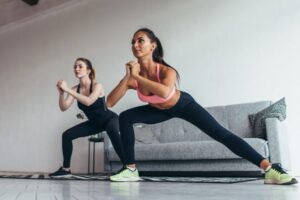
Hip Extension Bent Knee movements target the hip and hamstring muscles by applying them separately to the right and left legs. These movements are ideal for those who want to increase their hip strength. In addition, Lying Modified Hamstring Stretch movements performed for the right and left legs increase the flexibility of the muscles and accelerate the recovery process.
In advanced levels, versions of movements supported by weights that require balance and strength on one leg are preferred. In this way, imbalances between muscle groups are eliminated and performance is increased. Controlled movements reduce the risk of injury and increase the quality of training.
Leg Exercises at Home by Muscle Group
Leg muscles consist of many different areas, and correct exercises for each muscle group are very important for balanced development. In leg exercises to be done at home, different exercises targeting the front leg (quadriceps), back leg (hamstrings), hip, and calf muscles should be preferred. In this way, balance is achieved between muscle groups, and the risk of injury is reduced.
Front Leg Exercises at Home
The front leg muscles are actively used, especially while walking, running, and jumping. There are front leg exercises at home to strengthen these muscles, increase leg endurance, and gain an aesthetic appearance.
Rotational Lunge HEQ exercise works your leg muscles in multiple ways while also improving your balance and coordination. Clean to Side Lunge HEQ is a lunge movement done sideways and activates the front leg muscles as well as the hip and inner thigh muscles. These movements are quite effective for gaining unilateral strength and flexibility.
Chair Bulgarian Split Squat movements are performed by supporting yourself on a chair and working the front leg and hip muscles intensively. These exercises, which are done separately for the right and left legs, help reduce muscle imbalances.
It is important to pay attention to the correct position of the knees while performing the movement. Additional exercises such as step-up movements, squat variations done by leaning against the wall, and short-distance fast walks are also useful for supporting the front leg muscles. These exercises can be easily performed at home and do not require weights.
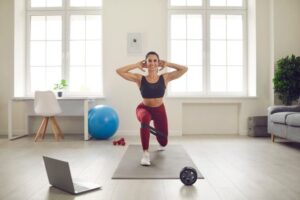
Hamstring Exercises at Home
The hamstring muscles, especially those covering the hamstring and hip area and provide strength, balance, and flexibility in the back of the legs. Effective hamstring exercises that can be done at home target this muscle group, supporting both muscle development and reducing the risk of injury. The Chair One Leg Hip Thrust movement is a hip lift exercise performed with one leg and effectively works both the hip and hamstring muscles. These movements, performed separately for the right and left legs, prevent muscle imbalances and increase hamstring strength. It is important to maintain the natural curve of the waist and lift the hips completely during the movement.
Among the back leg exercises at home, the Chair Frog Hip Thrust is an exercise performed with two legs and particularly activates the hip muscles. This movement shapes the hip muscles while also strengthening the lower back and hamstring muscles. When practiced regularly, it increases the tone of the back legs. The Chair Copenhagen Hip Adduction movements target the inner thigh and hip muscles. These exercises, performed separately for the right and left legs, increase muscle endurance and improve movement control. These movements are especially important for improving sports performance and preventing injuries.
How to Strengthen Legs at Home?
The basic element to strengthen leg muscles at home is to regularly apply the right exercises targeting muscle groups and programs suitable for your level. Choosing the right one for you among beginner, intermediate, and advanced level programs reduces the risk of injury and accelerates development. It is important to work the front leg, back leg, hip and calf muscles in a balanced way to increase the overall strength of the legs. Strengthening the muscles requires continuity and discipline. Trainings done on certain days of the week ensure the growth and endurance of muscle fibers. In addition, performing the movements with the right technique increases performance and minimizes the risk of injury.
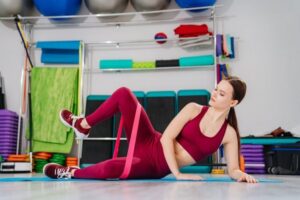
In your home leg strengthening program, you can include basic movements such as bodyweight squats and lunges, as well as supported exercises done in a chair and weighted exercises using dumbbells or resistance bands. Updating your program every few weeks according to the difficulty level will continue muscle development.
In addition, warm-up and stretching exercises are indispensable parts of training. Warming up the muscles increases performance, while maintaining flexibility prevents injuries. Nutrition and rest also play a critical role in strengthening the leg muscles.
How to Build Legs at Home?
Regular and planned leg-thinning movements and strengthening exercises performed at home are an effective method for shaping and developing leg muscles. Developing legs means not only gaining strength, but also toning the muscles and increasing endurance. For this reason, it is very important to organize the training according to your level.
At the beginning level, the muscles are activated with basic body weight movements, and over time, resistance is increased and intermediate and advanced level exercises are transitioned to. This progression supports development by providing continuous stimulation to the muscles. Leg training with weights at home allows the muscles to work from different angles and accelerates growth.
Leg muscles consist of different areas, such as the front leg, back leg, hip, and calf muscles. Working these muscle groups in a balanced manner is necessary for a symmetrical and aesthetic leg appearance. Basic movements such as squat, lunge, and hip thrust target all these areas of the muscles, while additional stretching and isolation movements support muscle development.
Sticking to the training program is the most critical part of the leg development process. Regular repetitions, correct technique, and appropriate rest periods ensure muscle recovery and growth. In addition, updating the training program at certain intervals prevents the muscles from adapting and increases the speed of development.
Home Leg Workout Program
A home leg and hip exercise program should be applied regularly and disciplined for muscle development and strengthening. Home leg training may vary for men and women. The home leg training program can be exemplified as follows:
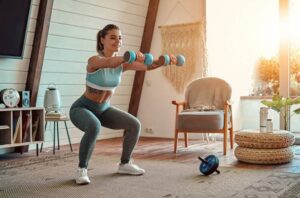
Program recommendation (3 days a week):
Day 1 – Basic Strength and Form:
- Bag Front Squat – 3 sets, 12 reps
- Chair Assisted Squat – 3 sets, 15 reps
- Bag Overhead Reverse Lunge – 3 sets, 10 reps (each leg)
- Rest: 60-90 seconds between sets
Day 2 – Intermediate and Flexibility:
- One Leg Hip Abduction Right & Left – 3 sets, 12 reps
- Standing Quadriceps Stretch Right & Left – 30 seconds each leg
- Lying Hamstring Stretch Right & Left – 30 seconds for both legs
Day 3 – Advanced Strength and Endurance:
- Cossack Squat – 3 sets, 8 reps (each leg)
- Prisoner Squat – 3 sets, 15 reps
- Hip Extension Bent Knee Right & Left – 3 sets, 12 reps
- Rest: 60 seconds between sets
For women, you can start with higher repetitions and body weight and add resistance bands or light dumbbells over time. It is important to do the movements in a controlled and technically focused manner. For men, leg training at home can be done with fewer repetitions and increasing weight and resistance. If strength and hypertrophy are the goal, 60-90 seconds of rest between sets is preferred. In addition to the movements recommended in the program, variety can be provided with supported movements done on the chair and other exercises in the application. Warming up before and stretching after training should not be neglected. Regular and disciplined practice is essential for the strengthening and development of leg muscles.


